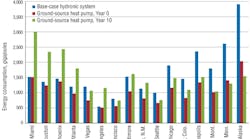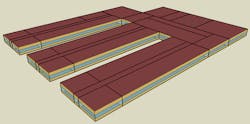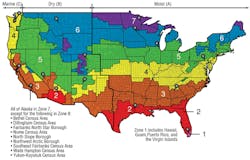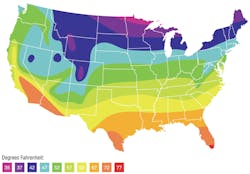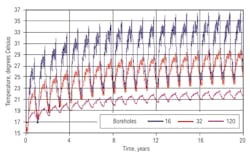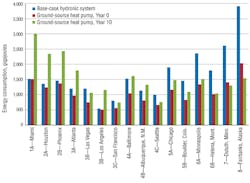According to ENERGY STAR, a joint program of the U.S. Environmental Protection Agency (EPA) and the U.S. Department of Energy (DOE): “The nation’s 17,450 K-12 school districts spend more than $6 billion annually on energy—more than is spent on computers and textbooks combined. As much as 30 percent of a district’s total energy is used inefficiently or unnecessarily. By being more energy-efficient, schools can help prevent greenhouse-gas emissions and improve the students’ learning environment. School districts can and have used the savings from improved energy performance to help pay for building improvements and other upgrades that enhance the learning environment.”1
MORE BY THIS AUTHOR: “Reducing Hospital CO2 Emissions With Condensing Boilers”
This article compares the energy performance of two air-conditioning systems common in schools across the United States: condensing-boiler heating systems and geothermal water-source-heat-pump systems. In the case of geothermal water-source-heat-pump systems, the article also compares the performance of new systems to that of systems older than 10 years.
The Energy Model
The analysis is based on the standard primary-school model developed by the DOE, Lawrence Berkeley National Laboratory, Pacific Northwest National Laboratory, and the National Renewable Energy Laboratory (NREL) under the Net-Zero Energy Commercial Building Initiative (Figure 1).2
All energy simulations were performed using the publicly available EnergyPlus 7.0.0.36 program developed by the DOE and the NREL.
Sixteen climate zones covering the entire spectrum of U.S. climate conditions (Figure 2) were modeled.
The analysis of the geothermal-heat-pump systems was based on ground-temperature profiles for the corresponding climate zones (Figure 3).
Two scenarios were simulated for the ground-source-heat-pump systems: new systems (Year 0) and long-term performance (Year 10). The second analysis was to account for long-term local degradation of ground-water quality (Figure 4).
Data were captured at 10-min intervals over 365 days in 16 climate zones with two ground-source-heat-pump configurations and one condensing-boiler-system option—a total of 2,522,880 data points. Figure 5 illustrates the outcome of the simulations.
As expected, the ground-source heat-pump systems were more efficient across all climate zones. However, this greater efficiency was susceptible to erosion from degradation of ground-water-energy-source quality over time. The lesson here is to assess long-term, as well as initial, design conditions when comparing systems.
Economics
Although their purchase and installation cost often is higher than that of other heating and cooling systems, geothermal-heat-pump systems, when properly sized and installed, deliver more energy per unit consumed than conventional systems. For further savings, geothermal heat pumps equipped with desuperheaters can produce domestic hot water as well as space heating. During summer, heat that is taken from a building is used to heat water for free. During winter, water-heating costs are reduced by about half.
Special financing and incentives are available to help offset the cost of adding a geothermal heat pump. These provisions are available from federal, state, and local governments; power providers; and banks offering specialized loans for energy-saving projects.
RELATED: “RSES Publishes Geothermal-Systems Guide”
Summary
This article highlighted some basic energy-use benchmark information. Much more research and investigation would be needed for a decision to install a new geothermal system or replace a traditional boiler system or low-cost electric-power-driven 18- to 20-SEER air-conditioning system.
Notes
1) Source: ENERGY STAR. (n.d.). Schools: An overview of energy use and energy efficiency opportunities. Retrieved from http://www.energystar.gov/ia/business/challenge/learn_more/Schools.pdf
2) The Benchmark buildings are discussed in more detail at http://bit.ly/Benchmark_Models. Also, see http://www.nrel.gov/docs/fy08osti/43291.pdf.
3) Source: Torcellini, P., et al. (2008). DOE commercial building benchmark models. Preprint of paper for presentation at the 2008 ACEEE Summer Study on Energy Efficiency in Buildings, Pacific Grove, CA. Retrieved from http://www.nrel.gov/docs/fy08osti/43291.pdf
4) Source: Bonnema, E., Studer, D., Parker, A., Pless, S., & Torcellini, P. (2010). Large hospital 50% energy savings: Technical support document. Washington, DC: National Renewable Energy Laboratory. Technical Report NREL/TP-550-47867. Retrieved from http://www.nrel.gov/docs/fy10osti/47867.pdf
5) Source: Eno Scientific, based on data available from the EPA.
6) Source: Fisher, D.E., & Rees, S.J. (2005, August). Modeling ground source heat pump systems in a building energy simulation program (energyplus). Paper presented at Ninth International IBPSA Conference, Montreal, Canada. Retrieved from http://www.ibpsa.org/proceedings/BS2005/BS05_0311_318.pdf
The general manager of R.F. MacDonald Co., provider of boiler and pump solutions for commercial and industrial applications, Ramez Naguib, PE, LEED AP, CEM, has worked on some of the largest and most sophisticated central cooling and heating projects in the world. He can be reached at [email protected].
Did you find this article useful? Send comments and suggestions to Executive Editor Scott Arnold at [email protected].









